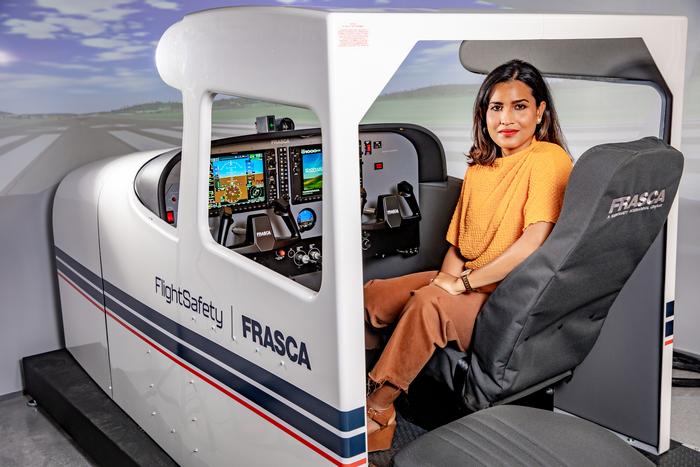
In a startling revelation from a recent study conducted at the University of Arkansas, mechanical engineer Neelakshi Majumdar highlights a critical concern in aviation safety: the alarming frequency of inflight loss of control incidents among general aviation pilots. With an average of four aircraft crashes occurring daily in the United States, the study emphasizes that nearly all the airplanes involved are single-engine craft. These figures underscore the pressing need for enhanced pilot training and awareness surrounding a significant cause of flight accidents—unintended aircraft departs from controlled flight.
Inflight loss of control, as defined by the Federal Aviation Administration, refers to moments when pilots unintentionally lose the ability to control their aircraft. This phenomenon is particularly prevalent in general aviation, which encompasses all non-commercial flights, including those conducted by private pilots. Majumdar’s groundbreaking research aims not only to investigate the underlying reasons behind these incidents but also to propose solutions that could improve pilot response and ultimately save lives. The findings, published in the internationally recognized Journal of Air Transportation, provide a critical insight into pilot experiences and the human factors contributing to inflight loss of control.
The central component of Majumdar’s research involved a comprehensive survey where nearly 200 surviving pilots disclosed their firsthand experiences with inflight loss of control incidents. This rigorous inquiry sought to uncover the human shortcomings that frequently lead to these dangerous scenarios. Unlike previous studies that leaned heavily on data from the National Transportation Safety Board, which varies in quality and detail, Majumdar’s approach directly engaged pilots, capturing valuable anecdotal evidence that highlighted a worrying trend: many pilots were reluctant to discuss their experiences due to the fear of repercussions, such as losing their licenses.
.adsslot_SdUsN4IpD5{width:728px !important;height:90px !important;}
@media(max-width:1199px){ .adsslot_SdUsN4IpD5{width:468px !important;height:60px !important;}
}
@media(max-width:767px){ .adsslot_SdUsN4IpD5{width:320px !important;height:50px !important;}
}
ADVERTISEMENT
Her research revealed that while some loss of control incidents were inherently the result of mechanical failures or abrupt weather changes, a significant number stemmed from human error. Factors such as inadequate skills, poor decision-making, and oversight often compounded the risks pilots faced. Some common pitfalls included initiating takeoff without checking airspeed or weight limits, misusing autopilot systems, and neglecting to follow essential checklist procedures. Most alarmingly, Majumdar noted that many pilots failed to properly acknowledge their aircraft’s worsening conditions—leading them to delay crucial recovery actions that could prevent disaster.
Majumdar uncovered a concerning trend regarding the types of pilots who participated in her study. Typically older and often retired, these professional aviators appeared less fearful of discussing previous inflight loss of control incidents. This age dynamic may suggest that younger pilots with more at stake are deterred from sharing their experiences, ultimately leading to a lack of open dialogue critical for understanding and mitigating risks associated with inflight loss of control.
The research also illuminated pervasive inadequacies in training infrastructure. Roughly one in four pilots indicated that they received insufficient training to effectively handle out-of-control situations, such as recovering from spins or other unusual attitudes. Even among those who underwent training for emergency procedures, many admitted to being ill-equipped to execute recovery techniques on command. This inconsistency in training raises pertinent questions about the standards and methods currently employed in pilot education.
The implications of Majumdar’s findings are broad and profound, emphasizing the urgent need for a paradigm shift in how aviation training is approached. She advocates for advancements in technology, such as flight simulators, which can dramatically enhance the quality and efficacy of pilot preparation. By simulating high-stress scenarios in a controlled environment, pilots could cultivate both the skills and confidence necessary to manage emergencies as they arise. Such innovations represent a potential cost-effective approach to training, making it accessible for a broader spectrum of pilots.
Moreover, Majumdar’s study suggests that improving pilot education in terms of inflight loss of control could significantly decrease the incidence of related accidents in general aviation. The stark contrast in safety records between general and commercial aviation emphasizes that pilots require more robust training resources tailored explicitly to their unique operational demands. Although it is impossible to eliminate all risks associated with flying, creating better-informed pilots is a tangible step toward enhancing the safety of general aviation flights.
Furthermore, Majumdar reinforces that a culture of transparency regarding inflight loss of control incidents must be fostered, encouraging open discussion among pilot communities. By reducing the stigma associated with participating in open forums or studies, new strategies and preventative measures could evolve from collaborative learning. More pilots might share their experiences if they felt secure from penalties, ultimately enriching the collective understanding of risk factors leading to loss of control incidents.
Majumdar’s work echoes an essential truth in aviation: the human factor remains at the forefront of safety examinations. While technological advancements continue to evolve, the complexities surrounding human behavior and decision-making remain critical to consider. Majumdar’s groundbreaking research paves the way for a more profound examination of human factors in aviation, with the potential not only to improve training procedures but also to save numerous lives by preventing future inflight loss of control events.
As the gravity of Majumdar’s findings permeates the aviation community, there is hope that both regulators and training institutions will prioritize pilot education reforms. By addressing the root causes of inflight loss of control and investing in pilot training, the industry can take crucial steps toward minimizing accidents and ensuring a safer flying experience for all.
In conclusion, Neelakshi Majumdar’s research on inflight loss of control presents an urgent call to action for the aviation industry. With data-driven insights and a relatable perspective from actual pilots, the work underscores the necessity for reevaluating and enhancing pilot training protocols. As the aviation community grapples with the realities of these incidents, both the pursuit of knowledge and the integration of effective training methodologies will be paramount to safeguarding the lives of those who take to the skies.
Subject of Research: Human Factors in General Aviation Loss of Control
Article Title: Human Factors in General Aviation Loss of Control: Survey of Pilot Experiences
News Publication Date: 27-Jul-2025
Web References: Journal of Air Transportation
References: None available
Image Credits: Credit: Whit Pruitt
Keywords
Tags: aviation safety solutionsFederal Aviation Administration guidelinesgeneral aviation safetyhuman factors in aviation accidentsimproving pilot response strategiesinflight loss of control incidentsNeelakshi Majumdar researchpilot experience surveyspilot training and awarenesssingle-engine aircraft crashesunintended aircraft departuresUniversity of Arkansas aviation study



